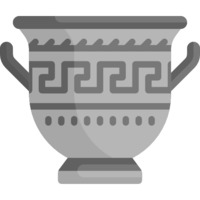Άγιος Τίτος
Αντικείμενο
Τίτλος Σημείου Ενδιαφέροντος
el
Άγιος Τίτος
en
Saint Titos Church
Περιγραφή / Απόσπασμα
236-241
en
The Greeks of Crete, considering St Mark as the protector of their foreign lords, used themselves to raise the standard of St Titus, whenever they rebelled against the Most Serene Republic. This was also done by the Venetian colonists, when they rose against their mother country, and united themselves with the Greeks of the island.
el
Οι Έλληνες της Κρήτης, θεωρώντας τον Άγιο Μάρκο προστάτη των ξένων αρχόντων τους, χρησιμοποιούσαν τους εαυτούς τους για να εξυψώσουν τη σημασία του Αγίου Τίτου όποτε εξεγείροντο εναντίον της Γαληνοτάτης Δημοκρατίας. Το ίδιο έπραξαν και οι Ενετοί άποικοι όταν ξεσηκώθηκαν εναντίον της μαμάς πατρίδας τους και ενώθηκαν με τους Έλληνες του νησιού.
Σύγχρονη περιγραφή
el
Ο ναός του Αγίου Τίτου στο Ηράκλειο είναι ένα από τα σημαντικότερα και παλαιότερα μνημεία στο κέντρο της πόλης και είναι αφιερωμένος στον Άγιο Τίτο, τον μαθητή του Απόστολου Παύλου και πρώτο επίσκοπο Κρήτης.
Το αρχικό κτίσμα πιθανότατα κατασκευάστηκε τον 10ο αι., όταν οι Βυζαντινοί ανακατέλαβαν την Κρήτη και μετέφεραν την έδρα της επισκοπής από τη Γόρτυνα στον Χάνδακα (σημερινό Ηράκλειο). Στον νέο ναό μεταφέρθηκαν η κάρα του Αγίου Τίτου, η θαυματουργή εικόνα της Παναγίας Μεσοπαντίτισσας και άλλα ιερά κειμήλια από το ναό της Γόρτυνας. Στο πέρασμα των αιώνων ο ναός καταστράφηκε και ξαναχτίστηκε αρκετές φορές, ενώ το 1210, όταν η Κρήτη πέρασε στην κατοχή των Ενετών, μετατράπηκε σε λατινική επισκοπή και το 1669, μετά την κατάκτηση του Χάνδακα από τους Οθωμανούς, έγινε μουσουλμανικό τέμενος, αφιερωμένο στον πορθητή Ζαδέ Φαζίλ Αχμέτ Κιοπρουλή. Τότε τα κειμήλιά του φυγαδεύτηκαν στην Βενετία όπου υπάρχουν μέχρι και σήμερα, με εξαίρεση την κάρα του Αγίου Τίτου που επιστράφηκε στο Ηράκλειο και βρίσκεται πλέον στο ναό. Με το μεγάλο σεισμό του 1856 ο ναός καταστράφηκε ακόμη μία φορά και ξαναχτίστηκε στη σημερινή του μορφή, από τον αρχιτέκτονα Αθανάσιο Μούση, ως ένα οθωμανικό τετρακιόνιο, εκλεκτικού ρυθμού τέμενος με τρούλλο. Μετά την ανταλλαγή των πληθυσμών, ο μιναρές του τεμένους γκρεμίστηκε και από το 1925, έπειτα από εργασίες ανάπλασης από την Εκκλησία της Κρήτης, ο ναός λειτουργεί κάτω από το ορθόδοξο δόγμα και είναι αφιερωμένος στον ισαπόστολο Τίτο.
Το αρχικό κτίσμα πιθανότατα κατασκευάστηκε τον 10ο αι., όταν οι Βυζαντινοί ανακατέλαβαν την Κρήτη και μετέφεραν την έδρα της επισκοπής από τη Γόρτυνα στον Χάνδακα (σημερινό Ηράκλειο). Στον νέο ναό μεταφέρθηκαν η κάρα του Αγίου Τίτου, η θαυματουργή εικόνα της Παναγίας Μεσοπαντίτισσας και άλλα ιερά κειμήλια από το ναό της Γόρτυνας. Στο πέρασμα των αιώνων ο ναός καταστράφηκε και ξαναχτίστηκε αρκετές φορές, ενώ το 1210, όταν η Κρήτη πέρασε στην κατοχή των Ενετών, μετατράπηκε σε λατινική επισκοπή και το 1669, μετά την κατάκτηση του Χάνδακα από τους Οθωμανούς, έγινε μουσουλμανικό τέμενος, αφιερωμένο στον πορθητή Ζαδέ Φαζίλ Αχμέτ Κιοπρουλή. Τότε τα κειμήλιά του φυγαδεύτηκαν στην Βενετία όπου υπάρχουν μέχρι και σήμερα, με εξαίρεση την κάρα του Αγίου Τίτου που επιστράφηκε στο Ηράκλειο και βρίσκεται πλέον στο ναό. Με το μεγάλο σεισμό του 1856 ο ναός καταστράφηκε ακόμη μία φορά και ξαναχτίστηκε στη σημερινή του μορφή, από τον αρχιτέκτονα Αθανάσιο Μούση, ως ένα οθωμανικό τετρακιόνιο, εκλεκτικού ρυθμού τέμενος με τρούλλο. Μετά την ανταλλαγή των πληθυσμών, ο μιναρές του τεμένους γκρεμίστηκε και από το 1925, έπειτα από εργασίες ανάπλασης από την Εκκλησία της Κρήτης, ο ναός λειτουργεί κάτω από το ορθόδοξο δόγμα και είναι αφιερωμένος στον ισαπόστολο Τίτο.
en
The church of Agios Titos (Saint Titus) in Heraklion is one of the most important and oldest monuments in the city centre and is dedicated to Agios Titos, disciple of Apostle Paul and first bishop of Crete.
The original building was probably built in the 10th century, when the Byzantines recovered Crete and transferred the seat of the bishopric from Gortyna to Chandakas (present-day Heraklion). The skull of Saint Titus, the miraculous icon of the Virgin Mesopanditissa and other sacred relics from the church of Gortyna were transferred to the new church.
Over the centuries the church was several times destroyed and rebuilt, while in 1210, when Crete came under Venetian rule, it was converted into a Latin bishopric while in 1669, after the conquest of Chandakas by the Ottomans, it became a mosque dedicated to the conqueror Köprülüzade Fazıl Ahmed Pasha. Then, the sacred relics were secretly transferred to Venice where they still are, with the exception of the skull of St. Titus which was returned to Heraklion and is now in the church.
During the great earthquake of 1856 the church was destroyed once again and it was rebuilt in its present form by the architect Athanasios Moussis, as an eclectic Ottoman, four- column mosque, with a dome.
After the exchange of populations between Greece and Turkey, the minaret of the mosque was demolished and from 1925, after renovation works performed by the Church of Crete, the church operates under the Orthodox doctrine and is dedicated to the apostle Titus.
The original building was probably built in the 10th century, when the Byzantines recovered Crete and transferred the seat of the bishopric from Gortyna to Chandakas (present-day Heraklion). The skull of Saint Titus, the miraculous icon of the Virgin Mesopanditissa and other sacred relics from the church of Gortyna were transferred to the new church.
Over the centuries the church was several times destroyed and rebuilt, while in 1210, when Crete came under Venetian rule, it was converted into a Latin bishopric while in 1669, after the conquest of Chandakas by the Ottomans, it became a mosque dedicated to the conqueror Köprülüzade Fazıl Ahmed Pasha. Then, the sacred relics were secretly transferred to Venice where they still are, with the exception of the skull of St. Titus which was returned to Heraklion and is now in the church.
During the great earthquake of 1856 the church was destroyed once again and it was rebuilt in its present form by the architect Athanasios Moussis, as an eclectic Ottoman, four- column mosque, with a dome.
After the exchange of populations between Greece and Turkey, the minaret of the mosque was demolished and from 1925, after renovation works performed by the Church of Crete, the church operates under the Orthodox doctrine and is dedicated to the apostle Titus.





